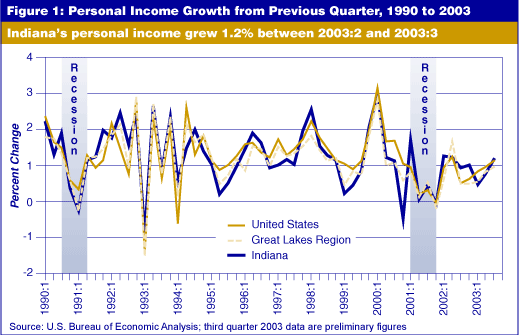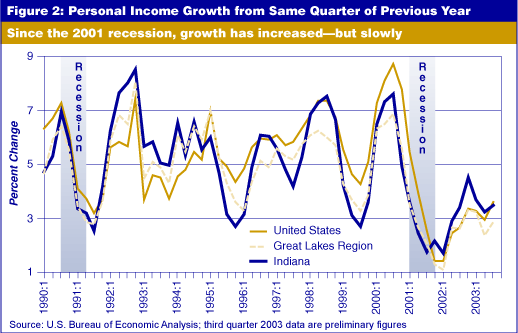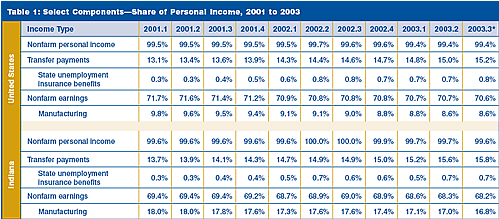Crawling Out of the Trough: More on Indiana's Personal Income
Indiana’s seasonally adjusted personal income increased from $178.7 billion for the second quarter of 2003 to $180.8 billion for the third quarter of 2003, yielding a quarterly growth rate of 1.2 percent. This is according to preliminary estimates from the U.S. Bureau of Economic Analysis. Barely greater than the U.S. rate of 1.1 percent over the same period, Indiana’s growth ranks 27th among the 50 states. With the estimate for the United States at more than $9.2 trillion, Indiana’s share of U.S. personal income is about 2 percent—a figure that has remained very stable since the early 1980s.
What is personal income? For those readers who are unacquainted with this jargon, it may not be what you think. It is more than just earnings from your source of employment. It consists of wages, salaries, employer-paid benefits and proprietors’ income; plus dividends, interest and rent; plus transfer payments (such as social security, welfare, disability and unemployment compensation) for which no services are rendered.
Quarterly Growth
Quarter-to-quarter growth rates since the first quarter of 1990 for Indiana, the Great Lakes region (Illinois, Indiana, Michigan, Ohio and Wisconsin) and the United States tell an interesting story (see Figure 1). Notice the boom, and then decline, in growth preceding the most recent recession (which began in March 2001, according to the National Bureau of Economic Research). Our efforts to claw our way upward since November 2001 (the end of the eight-month recession) resulted in some initial growth spurts, followed by relatively slow growth. This recovery pattern is quite unresponsive compared to that observed following the 1990–91 recession (which also lasted eight months). It seems we’ve faltered a bit while trying to climb out of the trough, but it also looks like we’ve recently achieved a slightly ascending trajectory.

The pattern of quarter-to-quarter growth rates can be a little bit herky-jerky, even when analyzing seasonally adjusted data as was done here. However, if we instead look at growth from the same quarter of the previous year, things smooth out a bit, providing a nicer image of the trends (see Figure 2). The verdict on recent progress is still the same, however. The phrase “I’ve fallen and I can’t get up!” comes to mind. Growth has increased, but at a crawl.

Components of Personal Income
To better understand the trends since the beginning of the 2001 recession, we will look at the proportions of a few select components of personal income for Indiana and the nation (see Table 1). Notice that the proportion of personal income attributed to transfer payments has consistently increased throughout the period under consideration, and Indiana’s percentage is continually a bit higher than that of the United States. From the first quarter of 2001 to the third quarter of 2003, the proportion of transfer payments for the nation increased from 13.1 percent to 15.2 percent, while that for Indiana increased from 13.7 percent to 15.8 percent.
One component of nonfarm earnings of particular interest to Hoosiers is the manufacturing sector. Indiana’s percentage reliably remains more than 8 percentage points higher than that of the United States, and the ongoing decline of the manufacturing sector is reflected in the data. From the first quarter of 2001 to the third quarter of 2003, the U.S. manufacturing component decreased from 9.8 percent to 8.6 percent, while the Hoosier state suffered a decrease from 18 percent to 16.8 percent. (Additional details on the various components of personal income can be found in the IN the News article)
However, perhaps the scenario for manufacturing income in Indiana is not as grave as it seems. The dollar figure for the manufacturing component nationwide has decreased from $848 billion to $791 billion, whereas for Indiana, it has remained right around $30 billion throughout the period. It’s all relative.
Vincent Thompson
Economic Analyst, Indiana Business Research Center,
Kelley School of Business, Indiana University

